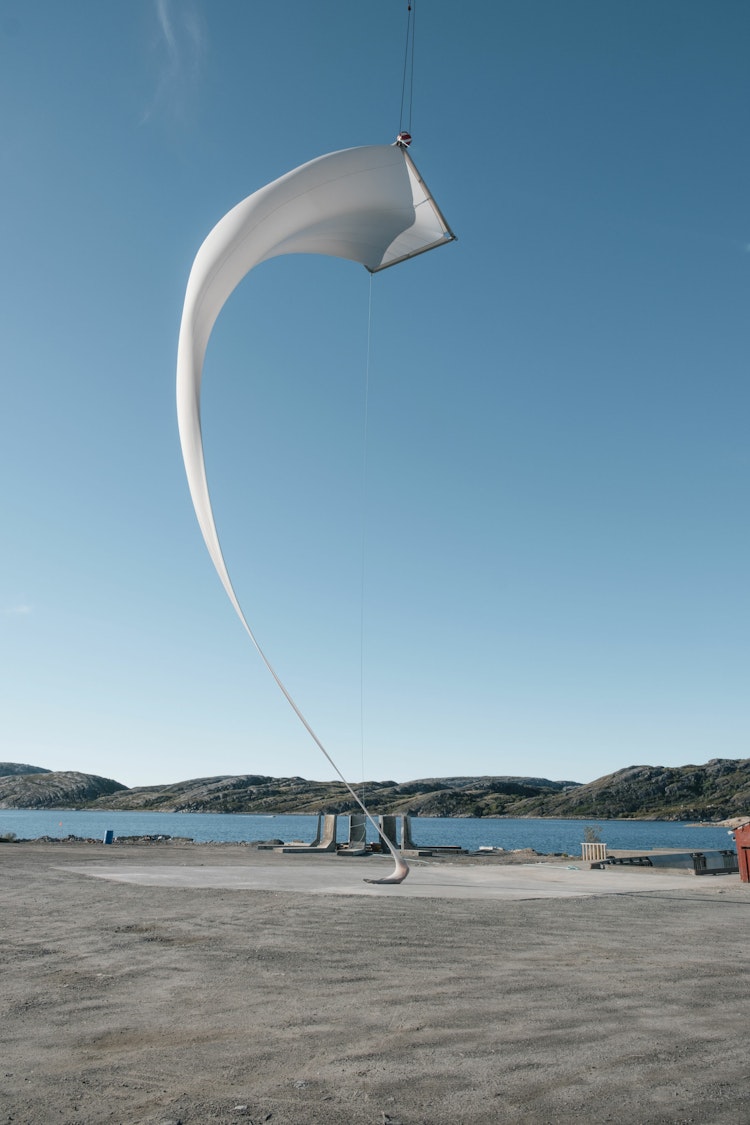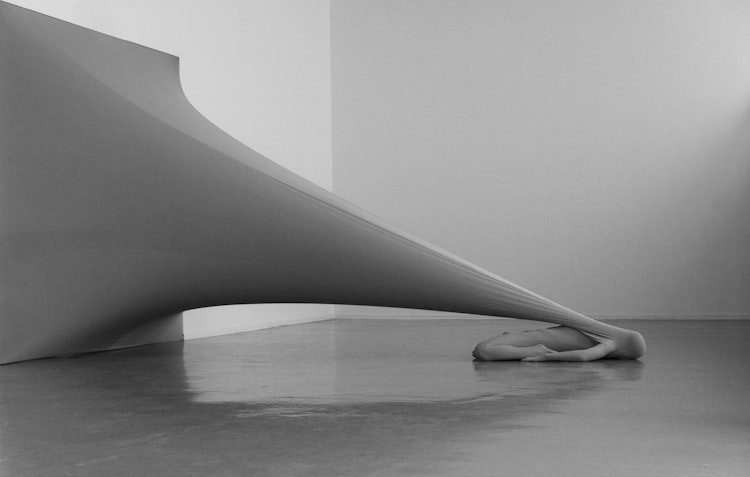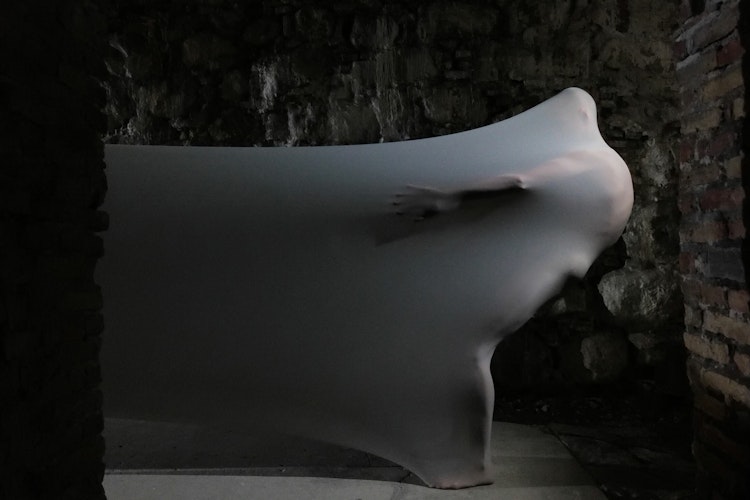

Istvan Virag, Georg Aamodt, Josh Lake, Audun Selnes, Malin Bülow, Dusan Reljin
by Malin Bülow
Jonathan Ibsen
Pernille Meidell
Josh Lake and Istvan Virag
Malin Bülow uses her artistic practice to explore interconnectedness, and to understand our bodies as being fundamentally part of the natural world and not separate from or privileged to it. In her performance installations, the moving bodies continuously shape-shift to suggest a resistance to given forms, renegotiating their own boundaries, as well as that of the architecture. She seeks to visualise a dependent body that can be seen as an expression of resistance and an initiative to liberation.
I work with elastic, translucent membranes and contemporary dancers to explore the liminal 1 space between inside and outside. The membranes, often monumental in size, anchor to rigid structures in the host-architecture, rendering geometric symmetry fused with corporeal presence. I usually describe my work as elastic interventions in a constant state of flux, originating in explorations of the self and the binary act of seeking liberation, while humbly embracing dependency.
Bodies and architecture seem contradictive of one another, the bodies being organic, malleable, soft, and flexible; the architecture rigid, (most often) straight, and filled with right angles — a representation of geometry and mathematical exactitude. I want to merge those clear contradictions — the organic shapes with the straight lines, the soft skin with the hard skeleton of the building, the fragile body with the sturdy architecture. And I want to talk about interconnectedness and an osmotic relation between self and the world.2 Naturally, we think of skin as the boundary between inside and outside, skin as the delineating membrane of what constitutes the self. Above all, I am trying to capture this self; what it means to exist, to feel, to think, to be in relation to others and in relation to the environment around us, within seemingly set systems of meaning and societal structures. Philosopher Maurice Merleau-Ponty3 writes about how we penetrate and define each other, and in line with posthuman feminist phenomenology and hydrofeminism4 I seek to understand our bodies as being fundamentally part of the natural world, and not separate from or privileged to it. The skin is porous — rather than being a clear-cut boundary, it connects us with other bodies and to our environment. Less than being sealed, our skin leaks; we are in constant process of intake, transformation, and exchange. This fluid character of our bodily boundary rhymes with what I am trying to express in my performance installations. The moving bodies continuously shape-shift to suggest a resistance to given forms, renegotiating their own boundaries as well as that of the architecture.
This fluid character of our bodily boundary rhymes with what I am trying to express in my performance installations.
En Caul (2023) Rosendal Teater. Photo by Josh Lake
The translucent, elastic membranes I am working with have a very skin-like touch; when stretched to their extreme, there’s seemingly nothing in between the body and the viewer – we see straight through. These qualities have been important in the development of the works. It gives me the freedom to create compartments and interstitial spaces that on the one hand are cocoon-like hiding spaces for the bodies to inhabit, but when they stretch them by dragging, leaning, pressing, and now also physically hanging in them, I’ll reach perfect transparency. And here’s an interesting ambiguity; because on the one hand the bodies seem protected and concealed, on the other hand they are visually fully exposed.
The character of the materiality, that it is highly translucent and at times seemingly invisible, along with its extreme elasticity and tensile strength, is highly intriguing to me. It makes me think of bodily cell membranes, of water surfaces, mist, and different sorts of delicate films. The threads are extremely thin, and the weaving pattern can hardly be seen at full stretch, something that makes it less of a textile and more of a film-like material. However, this seemingly fragile material carries the weight of a body. In my latest work, Levitation (2023), the body physically hangs inside the textile membrane. I wanted to challenge the limits of the material, and physically balance on the border of rupture. There's a certain tension that I am seeking on that border of collapse; the nerve-wracking excitement when something is at stake, doing what seems impossible.
There´s a certain tension that I am seeking on that border of collapse; the nerve-wracking excitement when something is at stake, doing what seems impossible.

I had the same feeling with AER (2022), a commissioned work for Bodø Biennale. In this work, a body on the ground anchors a 20 metre-long elastic funnel, attached to a spreader beam and a mobile crane approximately 25 metres up in the air. The wind sets the fabric in quite wild movement, and the body anchors and manages the wind throws, moving her upper body slowly up and down, breathing, without losing grip of the ground; something that proved to be quite demanding.
I strive to make my work phenomenological.5 I want to create a bodily experience that doesn’t need words, and that grabs the viewer on a personal, emotional, and experiential level. In general, I want to communicate a feeling that pends between nourishing protection and compelling restriction, where the first arouses serenity, the second, claustrophobia.
The nourishing protection might be traced to the metaphor of the cocoon or the watery womb, an umbilical cord kind of place. The porous placenta separating the two beings during gestation, yet facilitating direct exchange, is like an inside skin. The alien sense of being two inside one — of really sharing the inside space with a growing another you, of cells that fuse, volumes that grow, and tissues that stretch, belongs to the nourishing protection side of the work. And this side is calm, at times nearly meditative. When the bodily movements and the textile are in perfect concordance, I perceive my inner rhythms and my muscles in a state of total relaxation, as if my feet strike roots, and as if my arms and legs lose their muscular tension.
5 Phenomenology and art, in essence, seek to go beyond mere visual aesthetics; it aims to evoke profound and contemplative experiences, inviting viewers to explore the depths of their own consciousness and perception, this way blurring the boundary between the artwork and the observer, encouraging an active and personal engagement with the art.


Parallel and in opposition to this experience is the feeling of claustrophobic restriction. The bodies, even if they are fully free to stretch and move inside their membranous compartments, are still confined by their delineating nature. They might seem caught within one’s skin. And from a philosophical and political point, I think this boils down to the fundamental dilemma of freedom versus dependency, or rather the dual act of humbly embracing dependency while seeking liberation.



